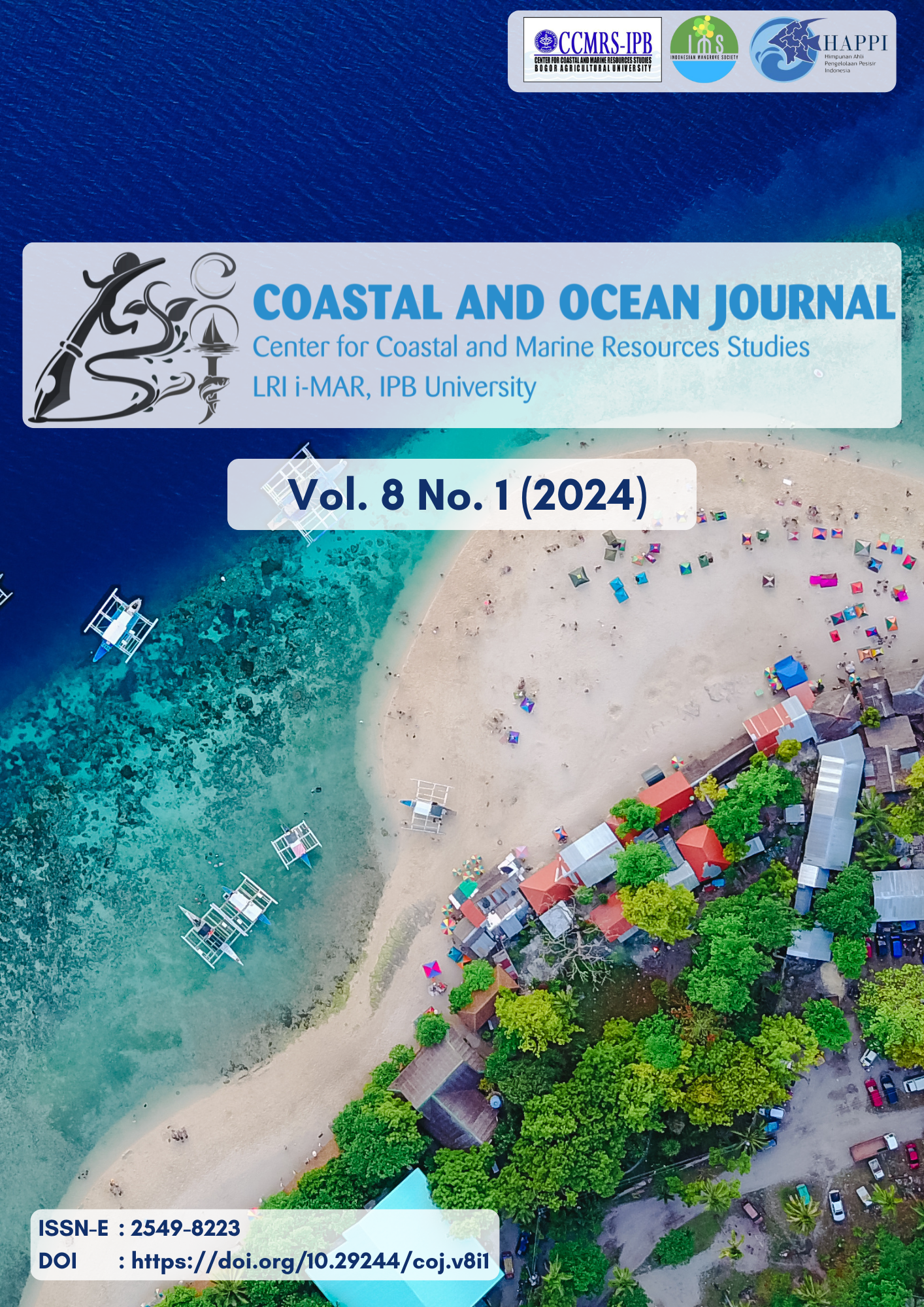CONCENTRATION AND EMISSION OF CARBON DIOXIDE (CO2) GAS IN MANGROVE ECOSYSTEM SEDIMENTS OF NANIA VILLAGE, AMBON CITY
Abstract
Mangrove ecosystem is a type of coastal ecosystem that has many benefits from both ecological, social and economic aspects. The role of mangroves in absorbing carbon reaches 965 tons C/ha. The ability to store carbon is four times more than other ecosystems. Besides absorbing and storing carbon, mangroves also release carbon through litter production. The production of mangrove litter will then experience decomposition resulting in a flux of greenhouse gases. One of the greenhouse gases that triggers climate change is carbon dioxide (CO2). The aim of this research was to determine the concentration and emission values of carbon dioxide (CO2) in the sediments of the mangrove ecosystem of Nania Village, Ambon City. Gas sampling using a syringe through a syringe mounted on a hood. Analysis of gas concentrations used the gas chromatography method. Sediment sampling is carried out using a small shovel on the surface of the substrate under the mangrove canopy. Sediment samples will be analyzed using a sieving process. The results showed that the average concentration of CO2 gas with the highest value in the sandy mud substrate with a value of 701.61 ppm and the lowest in the sand substrate with a value of 561.48 ppm. The largest CO2 gas emission in the mangrove ecosystem sediments of Nania Village was found in the sand sediment type of 75.0535 mg/m2/hour with an emission value, and the lowest was found in mud sediments, namely 30.1899 mg/m2/hour.
Downloads
References
Alongi DM, Mukhopadhyay SK. 2015. Contribution of mangroves to coastal carbon cycling in low latitude seas. Agricultural and forest meteorology. 213: 266-272.
Borges AV, Abril G. 2011. Carbon dioxide and methane dynamics in estuaries. Treatise on Estuarine and Coastal Science. 5: 119-161.
Castillo JAA, Apan AA, Maraseni TN, Salmo III SG. 2017. Soil greenhouse gas fluxes in tropical mangrove forests and in land use on deforested mangrove lands. Catena. 159: 60-69.
Chen GC, Tam NFY, Ye Y. 2012. Spatial and seasonal variations of atmospheric N2O and CO2 fluxes from a subtropical mangrove swamp and their relationships with soil characteristcs. Soil Biology and Biochemistry. 48: 175-181.
Chen GC, Ulumuddin YI, Pramudji S, Chen SY, Chen B, Ye Y, Ou DY, Ma ZY, Huang H, Wang JK. 2014. Rich soil carbon and nitrogen but low atmospheric greenhouse gas fluxes from North Sulawesi mangrove swamps in Indonesia. Science of the Total Environment. 487: 91-96.
Donato DC, Kauffman JB, Mackenzie RA, Ainsworth A, Pfleeger AZ. 2012. Whole-island carbon stocks in the tropical Pacific: Implications for mangrove conservation and upland restoration. Journal of environmental management. 97: 89-96.
Hartoko A. 2010. Oseanografi dan Sumberdaya Perikanan - Kelautan Indonesia. UNDIP Press. Semarang. ISBN: 978979- 704-892-1
Hakim, MA, Martuti, NKT, Irsadi A. 2016. Estimasi Stok Karbon Mangrove di Dukuh Tapak Kelurahan Tugurejo Kota Semarang. Life Science, 5(2): 87-94.
Huang X, Wang X, Li X, Xin K, Yan Z, Sun Y, Bellerby R. 2018. Distribution pattern and influencing factors for soil organic carbon (SOC) in mangrove communities at Dongzhaigang, China. Journal of Coastal Research. 34(2): 434-442.
Intergovernmental Panel on Climate Change (IPCC). 2001. Climate Change 2001: The Scientific Basis. Contribution of Working Group I to the Third Assessment Report of the Intergovernmental Panel on Climate Change. Cambridge University Press, Cambridge.
Konnerup D, Portela JMB, Villamil C, Parra JP. 2014. Nitrous oxide and methane emissions from the restored mangrove ecosystem of the Ciénaga Grande de Santa Marta, Colombia. Estuarine, Coastal and Shelf Science. 30: 1-9
Nugroho SH, Basit A. 2014. Sebaran Sedimen Berdasarkan Analisis Ukuran
Butir Di Teluk Weda, Maluku Utara. Jurnal Ilmu dan Teknologi Kelautan Tropis. 6(1): 229-240.
Rahman, Effendi H, Rusmana, I. 2017. Estimasi stok dan serapan karbon pada mangrove di Sungai Tallo, Makassar. Jurnal Ilmu Kehutanan. 11(1): 19-28.
Rahman, Wardiatno Y, Yulianda F, Rusmana I. 2020. Socio-ecological system of carbon-based mangrove ecosystem on the coast of West Muna Regency, Southeast Sulawesi-Indonesia. Aquaculture, Aquarium, Conservation & Legislation, 13(2): 518-528.
Supriyantini E, Nuraini RAT, Fadmawati AP. 2017. Studi Kandungan Bahan Organik Pada Beberapa Muara Sungai Di Kawasan Ekosistem Mangrove, Di Wilayah Pesisir Pantai Utara Kota Semarang, Jawa Tengah. Buletin Oseanografi Marina. 6(1): 29-38







